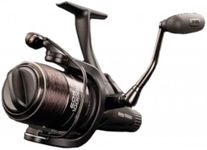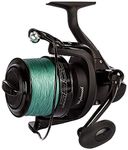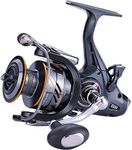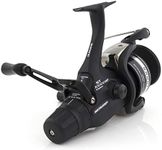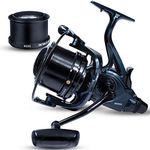Buying Guide for the Best Carp Reels
Choosing the right carp reel is essential for a successful and enjoyable fishing experience. Carp reels come in various types and sizes, each designed to meet different fishing needs and preferences. To make an informed decision, it's important to understand the key specifications and how they relate to your fishing style and the environments you plan to fish in. Here are the key specs to consider when selecting a carp reel.Reel TypeThe type of reel is crucial as it determines the reel's functionality and suitability for different fishing techniques. The main types of carp reels are baitrunner reels and big pit reels. Baitrunner reels have a secondary drag system that allows the carp to take the bait without feeling resistance, making them ideal for beginners and casual anglers. Big pit reels, on the other hand, are designed for long-distance casting and are preferred by experienced anglers targeting large carp in big waters. Choose a baitrunner reel if you are new to carp fishing or fish in smaller waters, and opt for a big pit reel if you need to cast long distances or fish in large lakes.
Gear RatioThe gear ratio indicates how many times the spool rotates with one turn of the handle. It affects the speed and power of line retrieval. A higher gear ratio (e.g., 6:1) means faster line retrieval, which is useful for quickly reeling in fish or when fishing in fast currents. A lower gear ratio (e.g., 4:1) provides more power and torque, making it easier to reel in large, heavy fish. If you often fish in fast-moving waters or need to retrieve your line quickly, a higher gear ratio is beneficial. For targeting large carp or fishing in slow-moving waters, a lower gear ratio is more suitable.
Line CapacityLine capacity refers to the amount of fishing line the reel can hold, usually measured in yards or meters. It is important because it determines how much line you can use, which is crucial for long-distance casting and fighting large fish. Reels with larger line capacities are better for fishing in big waters where long casts are necessary, while smaller line capacities are sufficient for smaller lakes and ponds. Consider the size of the waters you fish in and the size of the carp you target when choosing the line capacity. If you fish in large lakes or rivers, opt for a reel with a higher line capacity.
Drag SystemThe drag system controls the resistance a fish feels when it pulls on the line, allowing you to tire out the fish without breaking the line. A smooth and reliable drag system is essential for successfully landing large carp. There are front drag and rear drag systems, with front drag systems generally offering more precise adjustments and better performance. If you target large, powerful carp, a reel with a high-quality front drag system is recommended. For general carp fishing, a rear drag system can be sufficient and easier to adjust during a fight.
WeightThe weight of the reel affects the overall balance and comfort of your fishing setup. Lighter reels are easier to handle and reduce fatigue during long fishing sessions, while heavier reels may offer more durability and power. If you plan to fish for extended periods or prefer a more comfortable experience, choose a lighter reel. However, if you need a robust reel for targeting large carp or fishing in challenging conditions, a slightly heavier reel may be more appropriate.
Ball BearingsBall bearings in a reel contribute to its smoothness and overall performance. More ball bearings generally mean smoother operation and better durability. Reels can have anywhere from a few to over a dozen ball bearings. For a smooth and reliable fishing experience, look for a reel with at least 4-6 ball bearings. If you want the highest level of smoothness and performance, consider reels with more ball bearings, but keep in mind that this may also increase the reel's weight and cost.


